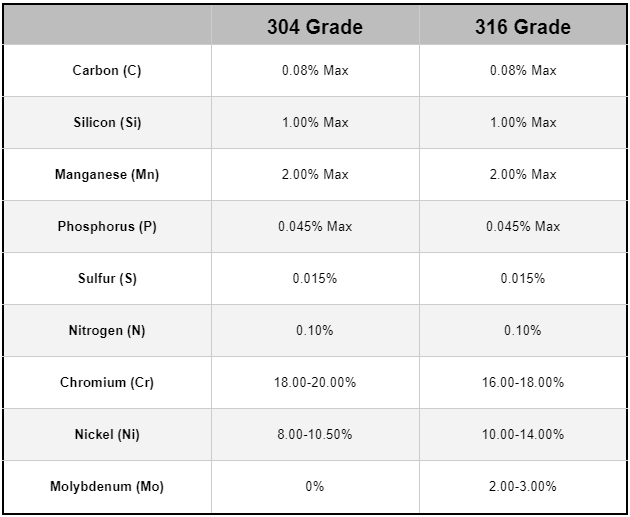Introduction to 300 Series Austenitic Stainless Steel
In the world of materials science, stainless steel is a true engineering marvel, and the 300 series austenitic grades are among its most celebrated members. These alloys combine strength, flexibility, and exceptional resistance to corrosion, making them ideal for a wide range of applications. Among the 300 series, grades like 304 and 316 stand out for their high quality and versatility, often used in industries where performance and durability are essential.

The Foundation of Stainless Steel: Chromium
Chromium is the key ingredient that gives stainless steel its name and its protective properties. It makes up at least 10% of the alloy, reacting with oxygen to form a thin, invisible layer of chromium oxide on the surface. This passive film acts as a shield, preventing further oxidation and rusting, which is why stainless steel remains "stainless" even under harsh conditions.
304 Stainless Steel: The Versatile Workhorse
304 stainless steel is the most commonly used grade in the 300 series, known for its excellent balance of strength, ductility, and corrosion resistance. It contains 18% chromium and 8% nickel, often referred to as 18/8 stainless. Its adaptability makes it suitable for everything from kitchen utensils and appliances to architectural components and industrial equipment, offering a reliable solution for everyday use.
316 Stainless Steel: The Corrosion-Resistant Champion
Building on the strengths of 304, 316 stainless steel adds molybdenum to its composition, enhancing its ability to resist corrosion—especially in environments with chloride exposure. With 16% chromium, 10% nickel, and 2% molybdenum, this grade is preferred in marine, chemical, and pharmaceutical settings where durability and reliability are critical.
A Comparative Look: 304 vs 316 Stainless Steel
While both 304 and 316 offer excellent performance, they excel in different conditions. 304 is ideal for general-purpose use where standard corrosion resistance is sufficient, while 316 is the better choice in more aggressive environments, such as coastal areas or chemical processing plants. The addition of molybdenum in 316 provides extra protection against pitting and crevice corrosion, making it more durable in challenging conditions.
Welding and Forming: The Common Strengths
Both 304 and 316 are highly formable and weldable, making them popular in manufacturing and construction. They can be shaped into complex forms without losing their structural integrity. Although they cannot be hardened through heat treatment, they gain strength through cold working. For applications requiring both welding and forging, low-carbon variants like 304L and 316L are often chosen due to their improved weldability and reduced risk of intergranular corrosion.
Typical Uses Across Diverse Industries
The applications of 304 and 316 stainless steels are vast and varied. 304 is widely used in kitchens, commercial buildings, and consumer goods due to its good corrosion resistance and ease of fabrication. On the other hand, 316 is favored in marine, medical, and chemical industries because of its superior resistance to saltwater and corrosive chemicals. While 316 is more expensive, its enhanced performance justifies the cost in demanding environments.
Super Austenitic Grades: Extending Performance
Beyond the standard 304 and 316 grades, there are super austenitic stainless steels designed for extreme conditions. These high-nickel alloys offer even greater resistance to corrosion and oxidation, making them suitable for high-temperature and highly corrosive environments. They are often used in specialized industrial and offshore applications where standard grades would fail.
Compositions of Austenitic Stainless Steel
Frequently Asked Questions
1. What makes 304 and 316 stainless steel resistant to corrosion?
Both grades contain chromium, which forms a protective oxide layer on the surface. In the case of 316, the addition of molybdenum enhances resistance, especially in chloride-rich environments like seawater.
2. How does the addition of molybdenum enhance the properties of 316 stainless steel?
Molybdenum improves 316’s ability to resist pitting and crevice corrosion, particularly in saline or acidic conditions, making it more durable in harsh environments.
3. What are super austenitic grades, and how do they differ from 304 and 316?
Super austenitic grades have higher nickel content and are designed for extreme conditions. They offer better resistance to corrosion and oxidation than standard 304 and 316, making them suitable for specialized applications.
Shop Stainless Steel Instrumentation Fittings
Shop Stainless Steel Cast 150# Fittings
Shop Stainless Steel Nipples
Shop Stainless Steel Forged 3000# Fittings
Shop Stainless Steel Flanges
Shop Stainless Steel Weld Fittings
Shop Stainless Steel Tubing
Industrial Hose Pump,Hose Pump,Heavy Duty Hose Pump,Industrial Peristaltic Hose Pumps
wuxi top mixer equipment co.,ltd , https://www.wxtpmixer.com